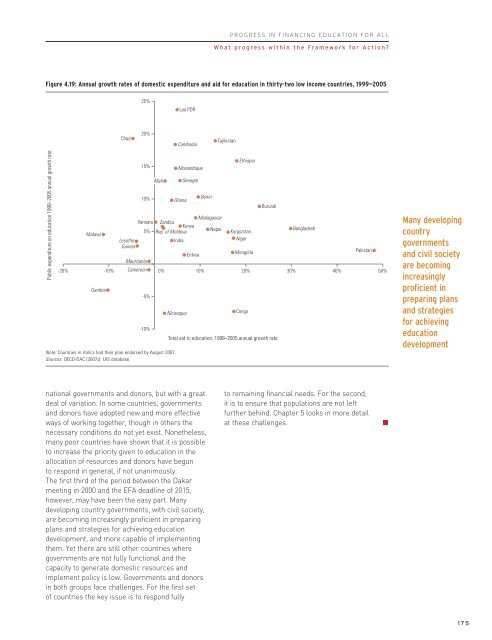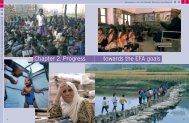Financing Education / pdf - Unesco
Financing Education / pdf - Unesco
Financing Education / pdf - Unesco
Create successful ePaper yourself
Turn your PDF publications into a flip-book with our unique Google optimized e-Paper software.
PROGRESS IN FINANCING EDUCATION FOR ALL<br />
What progress within the Framework for Action?<br />
Figure 4.19: Annual growth rates of domestic expenditure and aid for education in thirty-two low income countries, 1999—2005<br />
25%<br />
Lao PDR<br />
Chad<br />
20%<br />
Cambodia<br />
Tajikistan<br />
Public expenditure on education 1999–2005 annual growth rate<br />
Malawi<br />
15%<br />
10%<br />
-20% -10% Cameroon 0%<br />
10% 20% 30% 40% 50%<br />
Gambia<br />
-5%<br />
-10%<br />
Mali<br />
Nicaragua<br />
Mozambique<br />
Senegal<br />
Benin<br />
Madagascar<br />
Vanuatu Zambia<br />
Kenya<br />
5% Rep. of Moldova<br />
Nepal<br />
Lesotho<br />
India<br />
Guinea<br />
Eritrea<br />
Mauritania<br />
Note: Countries in italics had their plan endorsed by August 2007.<br />
Sources: OECD-DAC (2007c); UIS database.<br />
Ghana<br />
Ethiopia<br />
Kyrgyzstan<br />
Niger<br />
Mongolia<br />
Congo<br />
Burundi<br />
Total aid to education, 1999–2005 annual growth rate<br />
Bangladesh<br />
Pakistan<br />
Many developing<br />
country<br />
governments<br />
and civil society<br />
are becoming<br />
increasingly<br />
proficient in<br />
preparing plans<br />
and strategies<br />
for achieving<br />
education<br />
development<br />
national governments and donors, but with a great<br />
deal of variation. In some countries, governments<br />
and donors have adopted new and more effective<br />
ways of working together, though in others the<br />
necessary conditions do not yet exist. Nonetheless,<br />
many poor countries have shown that it is possible<br />
to increase the priority given to education in the<br />
allocation of resources and donors have begun<br />
to respond in general, if not unanimously.<br />
The first third of the period between the Dakar<br />
meeting in 2000 and the EFA deadline of 2015,<br />
however, may have been the easy part. Many<br />
developing country governments, with civil society,<br />
are becoming increasingly proficient in preparing<br />
plans and strategies for achieving education<br />
development, and more capable of implementing<br />
them. Yet there are still other countries where<br />
governments are not fully functional and the<br />
capacity to generate domestic resources and<br />
implement policy is low. Governments and donors<br />
in both groups face challenges. For the first set<br />
of countries the key issue is to respond fully<br />
to remaining financial needs. For the second,<br />
it is to ensure that populations are not left<br />
further behind. Chapter 5 looks in more detail<br />
at these challenges.<br />
175

















